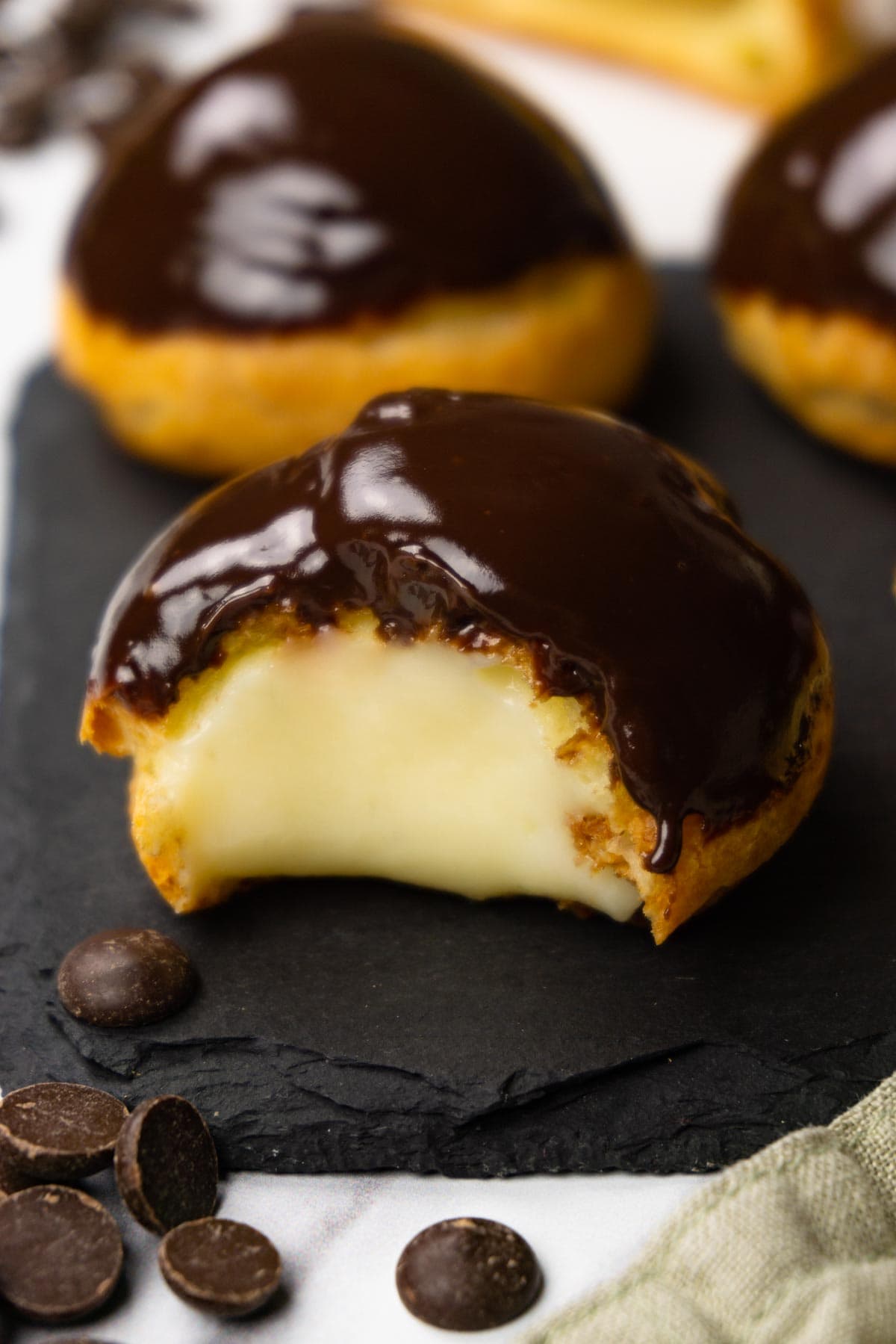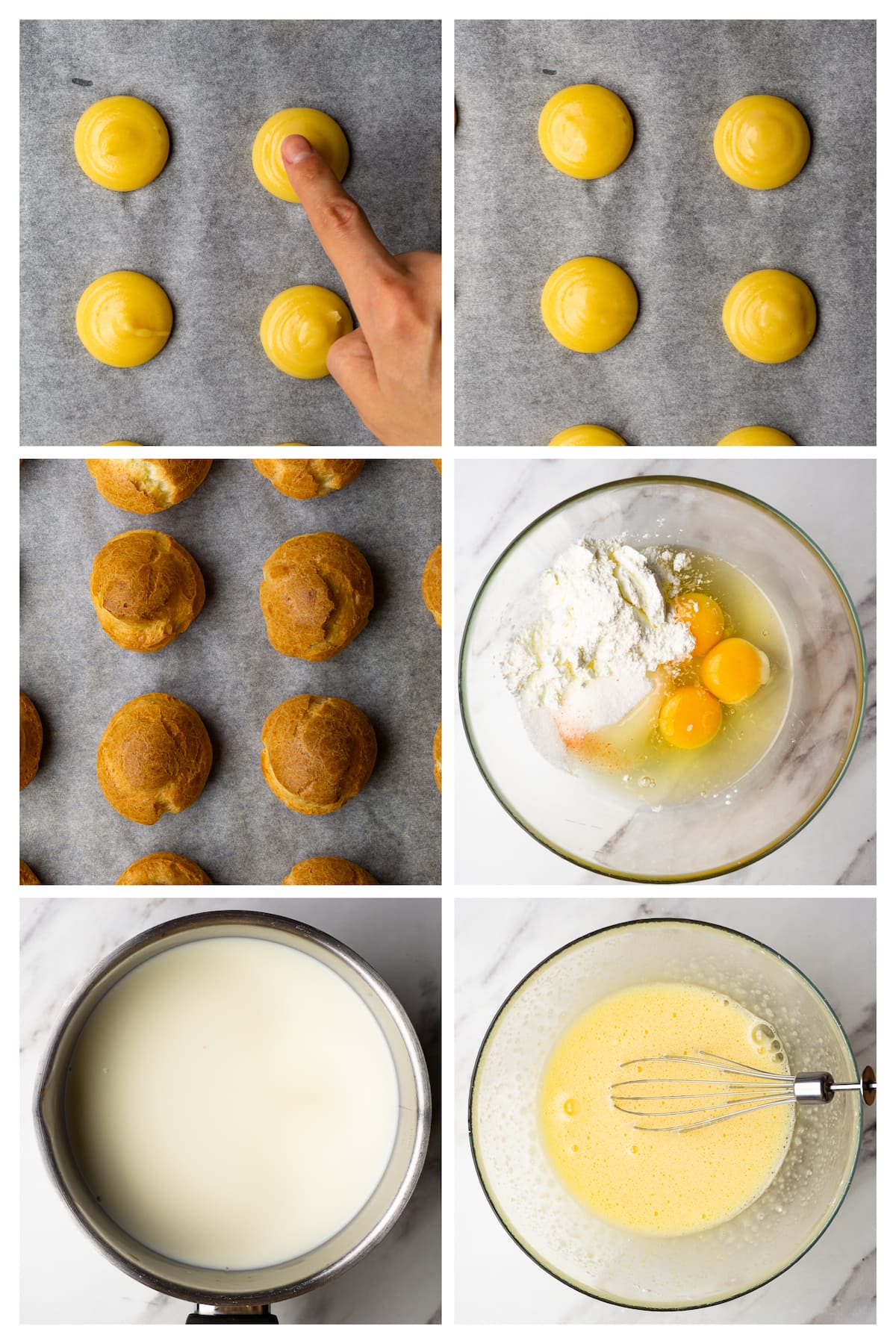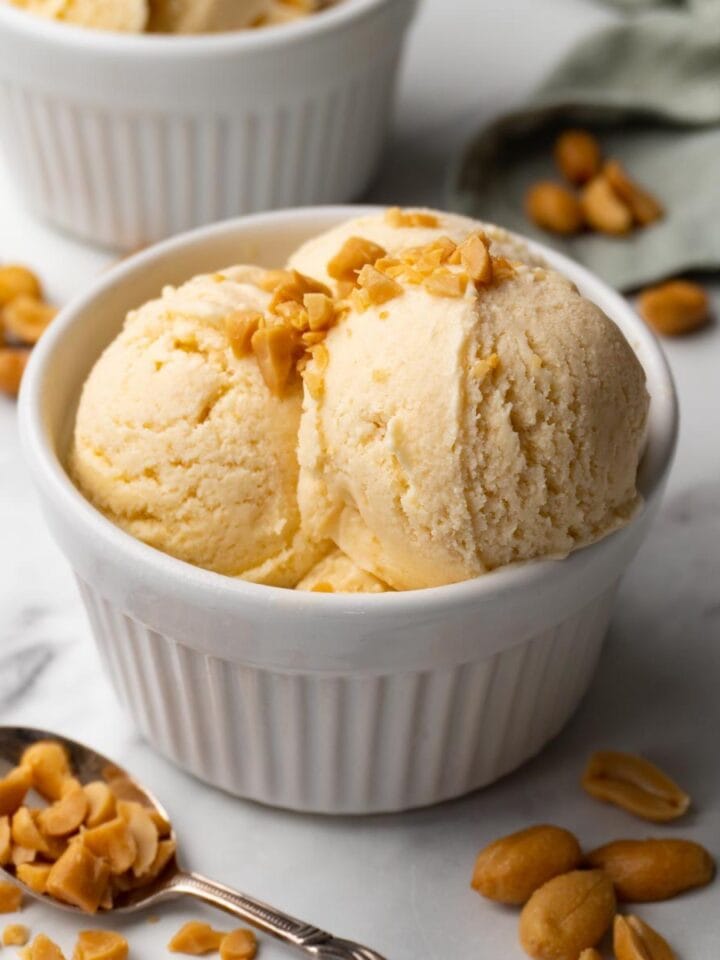These profiteroles with pastry cream filling and dark chocolate glaze are little, light, sweet treats that you can easily make at home. This dessert is not overly sweet and has a melt-in-your-mouth consistency.

Jump to:
Ingredients and substitutes
Flour – Use all-purpose flour to make choux pastry for our profiterole recipe.
Butter – You’ll need unsalted butter for the dough as well as for the pastry cream. The butter can be right from the fridge because we’re going to incorporate it into hot ingredients while it’s melting from the heat.
Milk and water – We need whole milk and water to make the dough (you can replace milk with the same amount of water, or you can replace the water with the same amount of milk) and whole milk to make the cream filling.
Salt and sugar – You’ll need white granulated sugar and salt to make the profiterole dough and the cream.
Vanilla extract – I use vanilla extract to make both the dough and the cream.
Eggs – The eggs for the dough should be at room temperature while the eggs that you use to make the cream can be cold.
Cornstarch – We need cornstarch to thicken the cream. It’s possible to replace it with flour but you’ll need to adjust the amount.
Chocolate – I use semi-sweet chocolate for the profiteroles’ chocolate sauce or chocolate ganache.
Heavy cream – You’ll need heavy whipping cream to make the chocolate ganache.

Cooking tips
Measure all ingredients correctly. As with my Cream puffs recipe, you need to use a digital kitchen scale to weigh all ingredients correctly.
Make the cream one day in advance. This classical French cream is fast to make but long to wait until it cools down. I recommend making it in the evening and leaving it in the fridge overnight. The next day, it will take you less than one hour to bake the puffs and fill them with the cream.
Taste test the custard. A very common mistake when making pastry cream is removing it from the heat too early. You get a thick consistency and think it’s done – however, the cornstarch needs a little bit of time to cook well and lose its starchy flavor and grainy consistency. That’s why you should cook your custard for 1-2 minutes after it thickens and taste it to make sure that it’s done.
Rotate the baking sheet during baking, but do so carefully. Most ovens have hot spots that make your dessert bake unevenly or burn on only one side. Profiteroles brown very fast, so if your oven has a hot spot some of them can burn. Rotate your baking sheet to brown your puffs evenly, but do so after the 20-minute mark or you risk deflating them.
Step by step directions
For the choux pastry
1. Preheat the oven to 190C or 375F and line a baking sheet with parchment paper.
2. In a saucepan, combine the milk, water, butter, salt, sugar, and vanilla. Heat over medium heat until it boils. Remove from the heat and add the flour all at once. Mix with a rubber spatula until no dry ingredients are left.

3. Bring back to the heat and cook the dough for 2-3 minutes, mixing continuously with the rubber spatula until a whiteish film forms on the bottom of the pan and the dough forms a ball with a homogenous consistency. Remove from the heat.
4. Place the dough in a stand mixer fitted with a paddle attachment. Beat the dough on low for a minute or until it’s not quite hot to the touch but still very warm.
5. Start adding the eggs a little at a time and beat on medium until incorporated. Then, add more eggs. Repeat until all eggs are incorporated. Scrape the sides and the bottom of the bowl and beat one last time just for a few seconds to mix. The dough should be smooth and when you lift the paddle, it should slowly fall from it leaving a V-shaped tail.
6. Transfer the dough into a piping bag fitted with a round nozzle. Keep the piping nozzle facing straight down toward the piping surface (0.5” or 1 cm away from it) and pipe 30 even 1 ½" or 4cm rounds, leaving 1" in between. Work in batches if needed.

7. Bake for about 25 minutes or until they’ve puffed up and golden brown.
8. Remove from the oven and let cool down on the baking sheet for 10 minutes, then place on a cooling rack to cool down completely. Pipe the second batch and bake.
For the pastry cream
1. In a bowl, combine the eggs, cornstarch, half of the sugar, and salt.
2. Heat the milk in a saucepan with the rest of the sugar until it starts simmering. Then, slowly pour into the bowl with the egg mixture, whisking vigorously. Pour the mixture back into the saucepan and return to the heat.

3. Cook the mixture over medium heat, whisking continuously. When it became pudding-like consistency, lower the heat to medium-low and cook for 2 minutes while whisking. Add the butter and vanilla to the hot mixture and mix until incorporated.
5. Pour the cream into a large dish, cover it with plastic wrap so it touches the mixture, and place it in the fridge to cool down.
6. When the profiteroles are at room temperature, remove the cream from the fridge and whisk to make it smooth again. Place in a piping bag.
Filling with cream and glazing
1. Cut a hole in the bottom of each profiterole with a small knife.
2. Cut off the tip of the pastry bag with cream, just enough to insert into the holes. Fill the profiteroles with the cream. There should be around 30g of filling per profiterole.

3. In a bowl, add the chocolate.
4. Heat the heavy cream in a saucepan until it starts simmering. Remove from the heat and pour over the chocolate. Let it sit for 2 minutes. Then, stir until homogenous in consistency.
5. Dip the top of each profiterole into the glaze and shake off the excess. Place on a plate to set for 10 minutes before serving.
Possible variations
Vanilla ice cream – Fill your piping bag with softened ice cream and pipe it inside the profiterole shells. Freeze like that or cover first with chocolate ganache. It will become your new favorite summer dessert.
Whipped cream – You can fill your puffs with sweetened powdered sugar whipped cream instead of custard cream.
Add flavorings to the cream – Instead of vanilla extract, you can add instant coffee, a little bit of chopped chocolate of your choice, or matcha tea powder to create new cream flavors. Matcha and coffee can be added to the milk at the beginning of cooking while the chocolate is better added right after you remove the custard from the heat.
Another glaze – Instead of warm chocolate sauce, you can use any sugar icing to finish your dessert. While your finishing layer is still sticky, you can sprinkle on freeze-dried berry bits, crushed nuts, or cocoa nibs on top.

FAQ
Yes, you can store choux pastry in a closed piping bag in the fridge for 1-2 days.
Yes, you can freeze them for up to 2 months. Thaw in the fridge overnight before filling with cream.
Store in an air-tight container in the fridge for up to 4 days.

More related recipes
Recipe card

Profiteroles
Equipment
- Digital kitchen scale
- Rubber spatula
- Stand mixer or hand mixer and a large mixing bowl
- Wilton 2A nozzle
- Piping bags
- Parchment paper
- Saucepan
- Whisk
Ingredients
For the choux pastry
- 75 ml whole milk can be cold
- 75 ml water can be cold
- 75 g unsalted butter can be cold
- 2 teaspoon granulated sugar
- ½ teaspoon salt
- ½ teaspoon vanilla extract
- 100 g all-purpose flour
- 3 large eggs 170g eggs (at room temperature) should be weighed without shells and lightly beaten in a bowl before using
For the cream
- 3 large eggs can be cold
- ½ teaspoon salt
- 45 g cornstarch
- 150 g white granulated sugar
- 550 ml whole milk can be cold
- 30 g unsalted butter can be cold
- 1 teaspoon vanilla extract
For the chocolate glaze
- 100 g semi-sweet chocolate chips
- 100 ml heavy whipping cream can be cold
Instructions
For the dough
- Preheat the oven to 190C or 375F and line a baking sheet with parchment paper.
- In a saucepan, combine the milk, water, butter, salt, sugar, and vanilla. Heat over medium heat until it boils. Remove from the heat and add the flour all at once. Mix with a rubber spatula until no dry ingredients are left.
- Bring back to the heat and cook the dough for 2-3 minutes, mixing continuously with the rubber spatula until a whiteish film forms on the bottom of the pan and the dough forms a ball with a homogenous consistency. Remove from the heat.
- Place the dough in a stand mixer fitted with a paddle attachment (you can also use a bowl and a wooden spoon). Beat the dough on low for a minute or until it’s not quite hot to the touch but still very warm (the ideal temperature should be 110F-140F or 43C-60C ).
- When ready, start adding the eggs a little at a time and beat on medium until incorporated. Then, add more eggs. Repeat until all eggs are incorporated. Scrape the sides and the bottom of the bowl and beat one last time just for a few seconds to mix. The dough should be smooth and when you lift the paddle, it should slowly fall from it leaving a V-shaped tail. It should be firm enough to hold a shape when piped out but moist. If this texture is achieved before all eggs are incorporated, stop adding them. If the texture is not there yet after you’ve added all the eggs, you need to add ¼ - 1 extra egg.
- Transfer the dough into a piping bag fitted with a round nozzle (such as Wilton 2A). Keep the piping nozzle facing straight down toward the piping surface (0.5” or 1 cm away from it) and pipe 30 even 1 ½" or 4cm rounds. Apply an even pressure, letting the rounds expand a little bit up and sideways. Leave 1" in between them. Work in batches if needed. The dough can wait in the piping bag while the first batch is in the oven. Dampen your finger with water and press down all the pointy tails on top of each round.
- Bake for about 25 minutes or until they’ve puffed up and golden brown on the top and the sides.
- Remove from the oven and let cool down on the baking sheet for 10 minutes, then place on a cooling rack to cool down completely. Pipe the second batch and bake.
For the cream
- In a bowl, combine the eggs, cornstarch, half of the sugar, and salt.
- Heat the milk in a saucepan with the rest of the sugar just until it starts simmering. Remove from the heat and slowly pour into the bowl with the egg mixture, whisking vigorously. Then, pour the mixture back into the saucepan through a sieve and return to the heat.
- Cook the mixture over medium heat, whisking continuously. When it thickens, lower the heat to medium-low and cook for 2 minutes while whisking. Remove from the heat. The mixture should resemble pudding and have no cornstarch flavor left. Add the butter and vanilla to the hot mixture and mix until incorporated.
- Pour the cream into a large dish, cover it with plastic wrap so it touches the mixture, and place it in the fridge to cool down.
- When the profiteroles are at room temperature, remove the cream from the fridge and whisk to make it smooth again. Place in a piping bag.
Assembling
- Cut a hole in the bottom of each profiterole with a small knife.
- Cut off the tip of the pastry bag with cream, just enough to insert into the holes. Fill the profiteroles with the cream. There should be around 30g of filling per profiterole.
- In a bowl, add the chocolate.
- Heat the heavy cream in a saucepan until it starts simmering. Remove from the heat and pour over the chocolate. Let it sit for 2 minutes. Then, stir until homogenous in consistency.
- Dip the top of each profiterole into the glaze and shake off the excess. Place on a plate to set for 10 minutes before serving.





Leave a comment